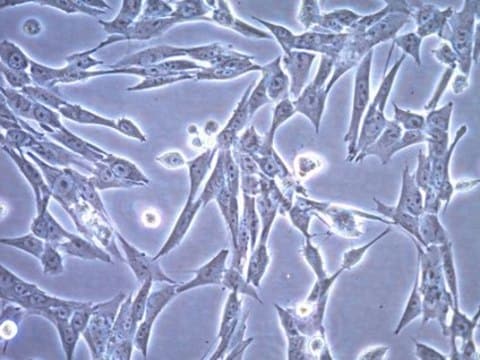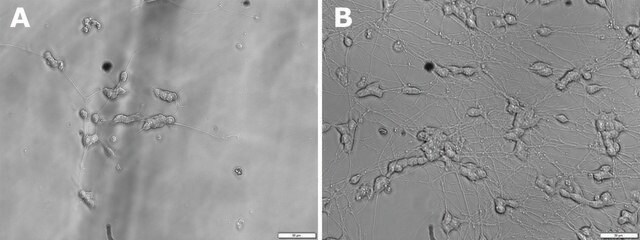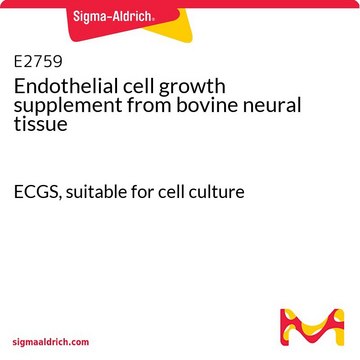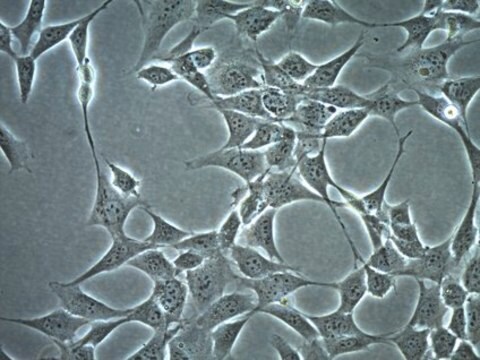SCC195
CT-2A-Luc Mouse Glioma Cell Line
Mouse
Synonim(y):
CT-2A Luciferase, CT2A Luciferase, mouse astrocytoma cell line
About This Item
Polecane produkty
Nazwa produktu
CT-2A-Luc Mouse Glioma Cell Line, CT-2A-Luc mouse glioma cell line is a valuable mouse model for therapeutic research on brain malignancies.
pochodzenie biologiczne
mouse
metody
cell culture | mammalian: suitable
Warunki transportu
ambient
Opis ogólny
References:
1. Weller M, Cloughesy T, Perry JR, and Wick W (2013) Neuro Oncol 15(1): 4-27.
2. Seyfried TN, Mukherjee P (2010) J Oncol 2010:961243 doi.10.1155/2010/961243.
3. Cotterchio M, Seyfried TN (1994) J Lipid Res 35(1): 10-14.
4. Binello E, Qadeer ZA, Kothari HP, Emdad L, Germano IM (2012) J Cancer 3: 166-174.
5. Martinez-Murillo R, Martinez A (2007) Histol Histopathol 22(12): 1309-1326.
6. Zimmerman HM and Arnold H. (1941) Cancer Res 1(12): 919-938.
7. Huysentruyt LC, Mukherjee P, Banerjee D, Shelton LM, Seyfried TN (2008) Int J Cancer 123(1): 73-84.
Source:
The parental CT-2A cell line was generated from a malignant astrocytoma formed via implantation of the carcinogen 20-methylcholanthrene in the cerebrum of a C57BL/6J mouse (6). The tumor was maintained through serial intracranial transplants prior to cell line isolation. The CT-2A-Luc luciferase cell line was clonally derived from CT-2A cells transduced with a lentiviral vector harboring a firefly luciferase (Fluc)-IRES-GFP cassette under control of the CMV promoter; cells were subsequently sorted for EGFP expression (7).
Opis linii komórkowej
Zastosowanie
Cancer
Oncology
Jakość
• Cells are tested negative for infectious diseases by a Mouse Essential CLEAR panel by Charles River Animal Diagnostic Services.
• Cells are verified to be of mouse origin and negative for inter-species contamination from rat, chinese hamster, Golden Syrian hamster, human and non-human primate (NHP) as assessed by a Contamination CLEAR panel by Charles River Animal Diagnostic Services.
• Cells are negative for mycoplasma contamination
Przechowywanie i stabilność
Kod klasy składowania
12 - Non Combustible Liquids
Klasa zagrożenia wodnego (WGK)
WGK 2
Temperatura zapłonu (°F)
does not flash
Temperatura zapłonu (°C)
does not flash
Certyfikaty analizy (CoA)
Poszukaj Certyfikaty analizy (CoA), wpisując numer partii/serii produktów. Numery serii i partii można znaleźć na etykiecie produktu po słowach „seria” lub „partia”.
Masz już ten produkt?
Dokumenty związane z niedawno zakupionymi produktami zostały zamieszczone w Bibliotece dokumentów.
Nasz zespół naukowców ma doświadczenie we wszystkich obszarach badań, w tym w naukach przyrodniczych, materiałoznawstwie, syntezie chemicznej, chromatografii, analityce i wielu innych dziedzinach.
Skontaktuj się z zespołem ds. pomocy technicznej





